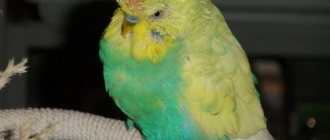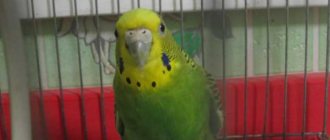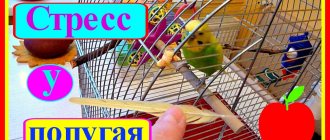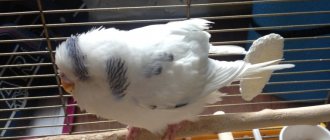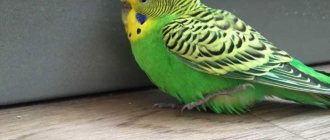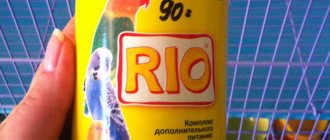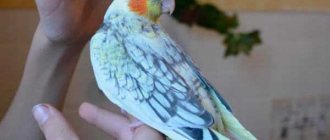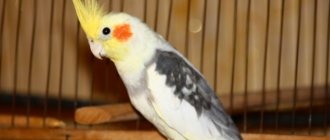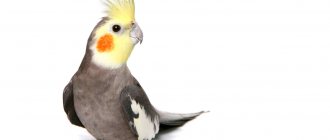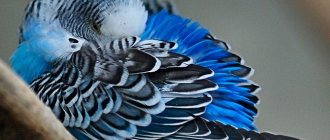Boiling activity, cheerful chirping and constant mischief - it's all about the budgie. We are used to thinking of wigglers as real living beings. And if it suddenly turns out that the parrot is sitting at the bottom of the cage, ruffling its feathers and closing its eyes, then this is a cause for concern. Why doesn't he fly or sit on a perch? This can be explained by observing the bird for a longer period of time. Let's look at a few possibilities.
Why does a parrot sit or lie at the bottom of the cage?
Parrots, like people, differ from each other in character and behavioral habits. But all of them are characterized by active fluttering, cheerful chirping and even talkativeness. And if cheerfulness suddenly gives way to depression, and instead of flying around the room, your feathered friend often sits or lies at the bottom of the cage, then this is alarming. This behavior can be explained by a number of reasons.
Normal behavior
It happens that a parrot sitting on the floor of the cage is the norm. For example, if a chick was born with some kind of pathology on its leg, then it is difficult for it to sit on a perch for a long time, but is more comfortable on the floor. In this case, such damage can be detected upon careful inspection. There is no reason to worry.
The female sitting in the corner of the cage indicates the onset of sexual maturity and readiness to mate, and maybe even waiting for the egg to appear. If the feathered girl is the only representative of her species in the house and no offspring are planned, then she urgently needs to remove the mirror in which she mistakes her reflection for a male from the cage, change the rattle and the general furnishings in the cage, do not put paper or other suitable material on the bottom to create a nest. This will help her get rid of the desire to lay eggs.
If your female has the same wavy friend, who has already become her “husband,” then you cannot cancel the clutch. We need to take care of the house quickly. The future mother will lay eggs in it and begin to hatch them, and the new father will look after her and feed her. You can get rid of unplanned offspring without exposing the female to stress. To do this, you need to scald the newly laid eggs with boiling water and return them to the nest to the unsuspecting mother.
Poor nutrition
A healthy parrot will go to the bottom of the cage from time to time, but never sit for long. If he sits there too long, it means he doesn’t feel well and can’t take off. The cause may be poor nutrition, resulting in the bird becoming too heavy due to obesity or too weak and emaciated.
Excess weight may appear due to:
- a sedentary lifestyle, when the bird is not allowed to fly out of its cage;
- the predominance of high-calorie feeds: canary seeds, hemp, oats.
To avoid such a critical situation, you need to:
- limit feeding of high-calorie grains, and give more fresh herbs, as well as raw fruits and vegetables;
- equip the cage with various perches, ropes, swings to increase the ability to actively move;
- Let the bird out every day for a few hours to fly freely.
The parrot may become weak due to the fact that the food has been changed to new food, which it is not used to eating. To prevent this from happening, you need to switch to a new type of food gradually, gradually adding it to your usual food. You need to buy only good quality concentrate.
Poisoning
Poisoning also deprives the bird's body of strength, which is why the parrot does not fly, but sits on the floor of the cage. Along with this, other symptoms appear: lack of appetite, vomiting, diarrhea, lack of coordination, body trembling, head tilted back. The causes of poisoning, in addition to low-quality and stale food, can be found throughout the apartment.
For example:
- indoor plants poisonous to birds: ivy, dieffenbachia, spurge, azalea;
- Alcoholic drinks and pure salt not removed from the dinner table;
- toxic fumes from Teflon cookware;
- toiletries containing hexachlorophene: cosmetic soap, deodorant spray;
- products containing mercury and other hazardous chemicals.
Diseases or parasite infestation
An exhausted bird sits or lies on its stomach all the time, breathes heavily and sleeps a lot if it is sick or infected with parasites.
Diseases that cause a parrot to sit:
- psittacosis, which spreads from sick birds or appears due to unsanitary living conditions;
- salmonellosis, which birds become infected with through food, water and from other birds;
- thyroid disease;
- gout is a joint disease that occurs due to excessive nutrition;
- goiter inflammation.
Signs of the disease, in addition to the fact that the feathered pet gets ruffled and sits for a long time at the bottom of its home, can be general weakness, diarrhea, refusal to eat, and swelling. Parasites also make the parrot suffer. They are internal, i.e. intestinal (roundworms), and external (fleas and ticks). It can become infected first through bad food and from sick birds, and secondly, also from infected relatives.
Prevention of parasite infection:
- feed only proven high-quality feed;
- observe quarantine when keeping several birds.
Improper feeding
The budgerigar is an active bird that is constantly on the move. A healthy parrot jumps from branch to branch, walks along the bottom and pecks grains, tears paper, but will not sit on the floor of the cage. So it’s not entirely clear why the parrot suddenly spends a lot of time downstairs. Probably his paws get tired of sticking to the perch and it’s more convenient for him to sit on the tray. The reason for this condition is poor nutrition: too much fatty food or lack of nutrients.
Obesity in a parrot
You should feed your pet not on demand, but on time, observing portion sizes. If you do not follow a diet, your parrot will become accustomed to overeating due to excess weight. A heavy body puts stress on the legs and wings. An obese bird has difficulty moving and is simply uncomfortable.
Monotonous food
A word of warning! It should also be noted that fasting is one of the causes of weakness in birds. The food may be of poor quality, and the parrot may not get enough of it. In some cases, malnutrition may be caused by switching to another food that the bird does not like.
First aid for a parrot
The metabolic process in parrots occurs very quickly, so if you notice warning signs that your pet is getting sick, you need to act immediately. It is necessary to give him first aid, and then show him to a veterinarian or ornithologist.
The symptoms of most avian diseases and poisoning are similar, so first aid is aimed at combating intoxication. For this purpose, the preparations “Enterosgel”, “Sorbex” are suitable, which need to be diluted with water in a ratio of 1:2 and given to the sick bird several times using a syringe without a needle.
You can also use activated carbon: you need to crumble it and let the parrot peck. For mild poisoning, these remedies should help, although if it is not poisoning, they will not cause harm. In case of severe intoxication or other illness, it is necessary to take your pet to a specialist.
Parrots are a source of great joy to their owners. Caring owners, in turn, are very attentive to their pets. They notice any changes in their behavior and provide them with timely help.
If you have a feathered pet, you need to learn how to properly care for it so that the bird feels cared for and loved and can reciprocate. It is necessary to create comfortable conditions for the bird and pay attention to it. After all, the positive emotions that she gives every day are much more than the time and money spent.
But sometimes an observant owner notices that the parrot is sitting at the bottom of the cage and is somehow drooping. What to do? We will talk about this in our article.
Causes and solutions
When a parrot gets into a house after being purchased, it can often sit with its ruffles at first. This is the only case in which you should not immediately sound the alarm. It takes several days for a “rookie” to adapt to an unfamiliar environment. Therefore, it is better not to disturb the bird, but to unobtrusively watch it from the side.
If the bird gradually shows interest in its new home, begins to drink and feed, then everything is in order. During this period, you need to treat him carefully, talk quietly and affectionately. Soon he will get used to his cage and household members, and will become sociable and nimble.
In all other cases, a ruffled bird is a reason for drastic measures. In domestic budgies, some pathologies develop rapidly, and delay can kill the pet.
There are several reasons when a parrot sits disheveled and apathetic, but is not sick. All situations require detailed study, since they can subsequently lead to various pathologies.
Cold
Wild budgies live in warm tropical climates. They genetically passed this feature on to their domestic “brethren.” Birds are comfortable at an air temperature of +22-23°C and a humidity of about 60% (permissible deviations 55-70%). Most often, birds freeze in the fall, when it is cold outside and the heating has not yet been turned on.
To keep warm, parrots ruffle their feathers, bury their beaks in their feathers, or hide their heads under their wings. In this position, the pet can sit for hours, occasionally changing position to stretch a little, eat or drink. If measures are not taken in time, the parrot first loses its appetite and then gets sick.
You need to react quickly:
- use a heater to increase the room temperature to +21-23°C. Do not place devices close to the cage, so as not to create a sharp change from cold to hot. The main thing is to organize soft heat;
- if the air is dry, use a household humidifier. If it is not there, place containers of water in different corners for a while or hang 1-2 wet towels. Once the parrot is warm and comfortable, it will perk up, spread its wings, and become active again.
For heating, you can use special heating mats. They are made for incubator-reared chicks, but are also suitable for parrots.
Lack of light
For budgerigars, sunlight is the main source of vitamin D. It is necessary for normal life. In addition, they subtly capture ultraviolet light. With a lack of light, birds not only weaken and “wither,” but also lose their visual acuity.
In these circumstances, the bird not only fluffs up, but may often squint and show irritability (sometimes aggression). To compensate for the lack of light, it is necessary to place the cage in a place flooded with sunlight for 1-2 hours every day. If it is cloudy outside for a long time, you need to use an ultraviolet lamp.
During the breeding season, budgerigars especially urgently need ultraviolet light. Lack of light negatively affects their reproductive system. Experienced breeders always increase daylight hours to encourage their pets to actively reproduce.
Fear or prolonged stress
Budgerigars are sensitive and vulnerable. They can be frightened by sharp sounds, loud music, noise and shouting of people. In such cases, the pet ruffles its feathers and hides its beak in its feathers. With such actions, the bird seems to be hiding from the world and trying to become invisible. If you pick it up, you can feel your heartbeat racing.
The same behavior means that your feathered friend is under stress. The following circumstances may cause it:
- the appearance of a pet in the house (cats, dogs and even hamsters);
- actions of small children (when they carelessly pick up a bird, make noise or cry loudly);
- placing another parrot in the cage, especially if the individuals are same-sex;
- use of household appliances or tools (food processor, hammer, drill and others).
Moving to another apartment, even for adult tame birds, is stressful. In the first days they adapt to a new place and need rest. Often, when frightened and under prolonged stress, parrots tremble and refuse to eat.
To normalize the pet’s condition, it is necessary to remove sources of anxiety. Ensure silence in the house, communicate quietly and affectionately, and ensure that the bird eats and drinks water on time. When the bird feels safe, its playful disposition will return.
If a parrot refuses to “get along” with a new individual in the same cage, then the bird that was introduced needs to be moved to another place. For a stressed bird, a change in environment will only worsen the anxious state.
Avitaminosis
Budgerigars ruffle their feathers and ruffle their feathers when they lack essential vitamins and minerals. Birds often suffer from vitamin deficiency when they have a monotonous and meager diet. You cannot give the same food day after day. A lack of nutrients is accompanied by additional symptoms:
- lethargy and apathy;
- loss of appetite;
- Tucking of the tail and trembling of the wings.
To restore health, you urgently need to diversify your diet. Introduce fresh vegetables, fruits, berries and herbs into your daily menu. Choose only high-quality grain mixtures, alternating different grains. Special courses of vitamins perfectly strengthen the body, but they can only be given as prescribed by a doctor.
Parrot behavior
An attentive owner knows the habits of his feathered friend well. But there are moments when his behavior, various movements, and unusual sounds cause bewilderment.
It happens that such changes are quite understandable, for example, puberty or such a reaction may be to new foods.
Budgerigars, for example, are distinguished by their changeable mood: they scream, have fun, repeat certain sounds, and sit at the bottom of the cage, ruffled.
But there are exceptions. Some birds like to sleep on a table or sit or lie on the bottom of the cage.
And it happens that such behavior means a deterioration in health, malaise or other health problems that have arisen. If you notice it in time, it will be faster and easier to eliminate this problem and cure your pet.
Stressful situations
If the parrot is cresting, but this is not caused by illness, the reason lies in the pet’s stressed state. The following may cause discomfort:
- the appearance of strangers in the house;
- lack of usual attention;
- unusual sounds;
- cell change;
- new relative;
- moving.
To help the bird, it is important to understand what caused the atypical behavior. Budgerigars love attention, so they get nervous when they don't get it. You can protect from extraneous noise by moving the cage to another room.
The cat or dog shows increased interest in the bird - another reason why parrots tremble. Usually, this happens until the pets get used to each other. A temporary measure would be to reduce contact: place the cage on a hill, move it to another room.
Desire to breed
It happens that a parrot sits or lies at the bottom of the cage for a long time. And then it rises, can fly up onto a perch or fly out of the cage. And then he looks completely healthy, full of strength and energy. It flies around the room, makes some sounds, sits on the owner’s arms or shoulders, and then flies again and sits on the bottom of the cage.
This may indicate a desire to lay eggs and have offspring. If you do not plan this, then first of all you need to remove the mirror from the cage in which the bird sees its partner, change accessories, for example, hang a new trinket, put up branches for climbing. There should be no paper, fabric or other things at the bottom that could provoke masonry.
Injury
Parrots can suffer from their careless behavior, from other animals or humans. As a result of mechanical damage, injuries of varying severity are possible. If the parrot is lying on its stomach, it may be weakened due to an infected wound, dislocation or fracture. In this case, there will be other signs of injury in the behavior and on the body of the sick bird.
- Depressed state, lack of appetite.
- Open wounds, cuts, swelling.
- Unnatural position of wings, legs, head.
It is important to prevent the possibility of injury. If damage occurs, then help the parrot as soon as possible. Depending on the severity of the exotic friend’s condition, treatment is carried out independently or by contacting an ornithologist.
Bad food
Sometimes the reason for this behavior is poor food. It is better not to use domestic food, but to replace it with imported food. In order for him to quickly get used to the new food, you need to gradually replace the old food with a new concentrate.
You can prepare the food yourself. You need to take the various cereals that you have. Buckwheat, millet, oatmeal, rice and boil a little will do. If the bird is weakened, you need to grind them and pour boiling water over them. Wrap the bowl with the porridge in a warm blanket and let it sit for 15–20 minutes. If the pet is so weakened that it cannot eat on its own, it must be fed. You need to take the cooled, but not cold, porridge into a syringe without a needle, take the bird in your hand, wrap it in a clean soft cloth so that only the head is on top. Hold it with three fingers: the thumb and middle one on both sides of the head, and the index finger on top of the head. Turn the head slightly to the side, open the beak with your fingernail and drop one drop of food into the corner of the beak. There's no need to rush. Wait until he swallows this porridge, then give him more. At one time you should try to give at least 1 1.5 ml of warm porridge.
Your pet should not live in the kitchen, especially if there are non-stick cookware. The bird should also not be given water from a tap or well unless it is boiled. This can be a breeding ground for bacteria for birds.
First aid
If the bird is not active outside the cage, then show it to an ornithologist or veterinarian as soon as possible.
This behavior may be a sign of poisoning. As first aid, you can give the bird smecta, which needs to be diluted as written on the bag and diluted with water 1:1, pour the sorbent into the beak over several doses with a syringe without a needle. Give the sorbent first every 50–60 minutes, then every two hours, and so on for two to three days. Drink an infusion of chamomile, which is replaced every few hours. You can eat rice, lightly boiled in water, adding carefully crushed karsil to the tablet. It should be given for about a month.
You should not feed your bird food that you eat yourself. If there is absolutely nothing else, then you can cook pasta without salt. And if you don’t want to eat at all, you can create an appetite and maintain strength by mixing 0.6 milliliters of 5% glucose and 0.4 milliliters of Ringer’s solution, Regidroni or saline solution and give 1 milliliter of the mixture to drink. These drugs can be bought at a regular pharmacy. This volume is suitable for a parrot or other bird that weighs 40–50 grams.
If the bird is poisoned, then such treatment will help, and if not, it will not harm.
Create good conditions for your feathered pets and many diseases and ailments can be avoided or prevented in a timely manner.
There is no need to delay treatment. The life of a feathered friend depends on it.
Responsible pet owners should carefully monitor their pet's health. In cases of deviations from the usual condition, immediately contact a veterinarian. If it has been noticed that the parrot is not feeling well and is breathing heavily, then you need to find out the reason for this behavior. The failure can be harmless - from severe fright from a loud sound - to severe forms of many diseases.
Problems and treatment
Trembling and shaking appear as symptoms of poisoning. Intoxication is also indicated by vomiting, diarrhea, refusal to eat, and loss of coordination. A low concentrated solution of activated carbon can help the bird. If it doesn’t help, give the bird 1 drop of cerucal until remission occurs.
When a parrot constantly sleeps and fusses, this is a sure sign of an infectious disease. Birds can become infected with psittacosis, as evidenced by swelling in the eye area. For treatment, tetracycline antibiotics are used: 3-5 drops twice a day, directly into the beak. Course - 7-10 days.
Another common infectious disease of parrots is mycoplasmosis. The main difference from the previous disease is the presence of wet feathers around the eyes. Baytril is used for treatment: 2-3 drops per 50 ml of drinking water daily for 5-7 days. Each time there is a new portion.
Why a parrot hides its head and beak in its wings and sits like that for a long time can be explained by several reasons. Birds rest like this, but in the process they rest on only one paw. If the support is on two legs, then the cause is pneumonia. Make a solution of Ciprofloxacin by dissolving 1 tablet in 5 ml of water. Add 40% glucose in a 1:1 ratio and feed your pet twice a day, 2 drops. The course lasts 7-10 days.
Description
Often, owners of parrots and other ornamental birds notice that their pet is breathing heavily only when it is sick, and the disease progresses, affecting the general well-being of the bird. If you notice breathing abnormalities on the first day, this will make further treatment easier.
How to help a parrot if he has trouble breathing
To correctly prescribe therapy by a veterinarian, you need to note in advance the changes that have occurred with the parrot. These may include sudden changes in weight, inappropriate behavior, convulsions and tremors of the wings. It is important to monitor whether the beak is open or closed when breathing, and whether extraneous sounds or noises are heard. This will help in making a clearer and faster diagnosis.
Sign of illness
If the parrot is ruffled and sitting at the bottom of the cage, this may be a sign of illness.
If he sleeps longer than before, does not clean his feathers, is disheveled, lethargic, then this is a reason to see a doctor.
A healthy bird will never stay at the bottom of the cage for long.
Feathered pets may have toxicosis, helminths or protozoa. Infection can also occur from bad food.
You should also pay attention to the droppings, which will show how the intestines work. If it is liquid, has changed its color, the anus is red. It could be diarrhea. You need to give activated charcoal and chamomile infusion. You can give it instead of water during treatment, just change the contents more often and clean the drinking bowl. You can also use a syringe without a needle or a pipette to pour it directly into the beak. If the bird did not fall or hit, then it needs to be warmed up. We recommend warming the bird under a 40-60 W table lamp. One side of the lamp can be covered if the parrot wants to move away from the bright light to a darker corner. Watch it so it doesn't overheat. If it begins to open its beak and breathe, and opens its wings, then the heating must be stopped.
And of course, don’t delay visiting an ornithologist or veterinarian. These birds have a very high metabolism, all processes proceed quickly, so it is so important not to be late. Especially if the parrot is already sitting at the bottom of the cage.
Possible diseases
If the parrot is breathing heavily, behaves sluggishly, or has lost its appetite, this indicates health problems or improper living conditions. Whistling and wheezing when breathing most often indicate colds. These symptoms appear with inflammation of the air sacs, with bronchitis and tracheitis. If convulsions and shaking of the head are added to difficult breathing, these are deviations in the nervous and cardiovascular system. A bird falling on its feet after a long swim may indicate hypothermia in the water.
Respiratory diseases
A distinctive feature of the respiratory system of birds is the presence of air sacs. They are designed to increase the volume of inhaled air, thermoregulation and water-salt metabolism. The larynx does not have vocal cords, but serves to isolate the trachea when eating. This increase in the length of the respiratory system also has a negative side - birds are more susceptible to harmful substances, bacteria and fungal spores in the air.
Inflammation of the trachea
Tracheitis occurs not only as a result of prolonged hypothermia, but also in case of poisoning with volatile toxic substances (aerosols, strong-smelling chemicals, perfumes), the presence of a foreign body in the throat, or infection with parasites.
Clinical picture of the disease:
- increased breathing;
- increased heart rate;
- narrowing of the larynx, swelling of its mucous membranes;
- the parrot breathes with its beak open;
- increase in body temperature.
During auscultation - listening to sounds that are formed in the internal organs - there are light and air sacs without extraneous noise.
But the diagnosis cannot be made based on the above symptoms. To confirm it, a tracheal smear for bacterial culture is required. Antibiotics, inhalations and immunomodulators are prescribed for treatment.
Why did the budgie get ruffled?
Having noticed that a budgerigar has become ruffled, not every owner immediately understands the reason. If you don't pay attention to this and just wait for everything to get better, you can waste time. Any change in the behavior of a feathered pet requires intervention. Let's talk about what causes the state of frizz and how to help a tame wavy.
Cold
Delicate ornamental birds are afraid of drafts; even a light summer breeze is harmful to them. A cold is manifested by sneezing, runny nose, and later a cough. The parrot refuses food and sits for a long time, huddled in a ball and with its feathers spread out. Thus, he tries to conserve energy and keep warm. How to help, how to treat if a parrot has been cresting for several days?
First aid:
- Humidify the air. Increased dryness harms the respiratory system, the condition of the bird worsens;
- Let's drink a warm infusion of chamomile with a drop of lemon juice. This drink relieves inflammation and strengthens the immune system;
- Use steam inhalation. Pour crushed chamomile flowers with hot water and place the container near the cage. By inhaling healing air, the bird will stop coughing faster.
If the above methods do not help within one to two days, contact your veterinarian. After a medical examination, it will be clear why the ruffled parrot looks so sick. Perhaps his illness has a more serious origin than a cold.
Causes not related to the disease
If a parrot has a sad ruffle, this does not mean that it is physically ill. The bird is often worried due to some external stimuli. When there are no other manifestations of the disease, short-term chills and frizz are probably caused by fear or cold.
Fear and stress
Budgerigars have a very weak heart and are extremely shy. These birds can be unsettled by loud music, sharply turned on lights, or children running around.
When experiencing stress, a budgerigar hides its beak on its back and crests, shrinks, trying to become invisible. His heart is pounding, ready to jump out of his chest.
If you notice this behavior, eliminate the irritants, and then calm your pet.
Freezing
In the room where the budgerigar lives, the air temperature must be at least 22 degrees. The heat-loving bird, although covered with dense feathers with down, is very sensitive to low temperatures. This is especially true for those who are going through a molting period. Having frozen, the ruffled parrot hides its beak in the feathers of its back, under its wing. He is half asleep, barely moving, trying to warm up.
Not enough light
Another reason why a parrot often sits with its ruffles is the short daylight hours. In winter, you need to artificially increase the length of the day: turn on an ultraviolet lamp in the evenings.
Not only the duration of light exposure is important for the parrot, but also the quality of the light.
Birds need vitamin D, and it is produced in the body under the influence of open sun or rays from special devices.
We recommend reading: Where is the homeland of budgerigars
Prevention
In order to avoid serious respiratory diseases, it is necessary to monitor the living conditions of the parrot. Hypothermia, drafts and outdoor swimming should not be allowed.
The room where the bird's cage is located should not be damp. A prerequisite is a sufficient level of lighting. Do not wash or treat the cage with aggressive chemicals, smoke near the bird, or use aggressively scented perfumes or aerosol air fresheners. Any colds must be treated promptly. Prevention of stroke comes down to adequate physical activity for the bird, but remember, the parrot cannot be prevented from flying.
